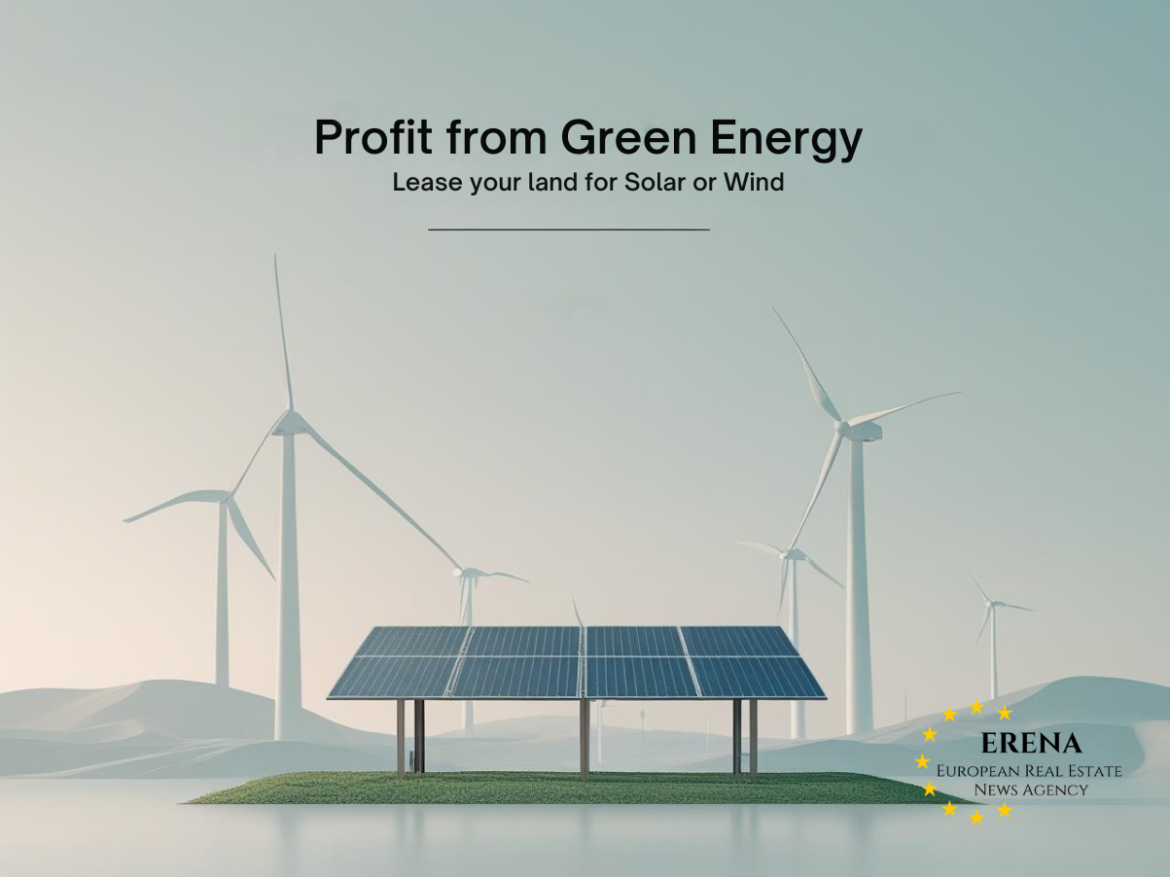As the demand for renewable energy continues to accelerate across the globe, landowners are increasingly discovering a highly profitable and low-maintenance opportunity: leasing their land for solar or wind energy projects. Whether you own farmland, unused acreage, or even marginal land with limited agricultural value, it could generate consistent passive income for decades — all while supporting the transition to green energy.
Why Leasing Your Land Is a Smart Investment
Steady Long-Term Revenue
One of the primary benefits of leasing land for renewable energy is the predictable, long-term income it provides. Lease agreements typically range from 20 to 40 years, with guaranteed payments and built-in escalations to account for inflation. Landowners retain ownership and receive rent without having to invest in equipment or infrastructure.
Typical rental rates include:
- Solar farms: €1,500 to €5,000 per hectare annually
- Wind turbines: €4,000 to €10,000 per turbine per year
- Hybrid projects: can exceed €10,000 per hectare annually depending on configuration
This setup can be especially attractive for land that isn’t generating meaningful income through farming or other uses.
No Upfront Costs or Technical Responsibilities
Energy developers take on all technical, financial, and legal responsibilities — from feasibility studies and permits to construction, maintenance, and eventual decommissioning. As a landowner, you are not required to manage or invest in the project, making it a low-risk, hands-off revenue stream.
Environmentally and Socially Responsible
Leasing land for renewable energy not only creates income but also supports sustainability goals. You’ll be helping reduce carbon emissions and contributing to a cleaner energy future. Many landowners also appreciate the positive public perception associated with renewable energy participation.
What Kind of Land Is Suitable?
To be considered viable for solar or wind energy development, your land should meet some basic criteria:
For Solar Projects:
- 5 hectares or more of flat or gently sloped land
- Strong solar exposure with minimal shading
- Proximity (ideally within 1–3 km) to electrical grid connections
- Good vehicular access for equipment and construction
- Not in protected or environmentally sensitive areas
For Wind Projects:
- 20+ hectares with average wind speeds of at least 6 m/s
- Sufficient distance from residential areas (typically 500–1,000 meters)
- No major obstructions or zoning restrictions
- Optionally, agricultural activity can continue between turbines
Some developers offer to lease portions of land or combine projects with ongoing agricultural use — maximizing both ecological and economic productivity.
The Leasing Process
- Developer Assessment
The energy company evaluates your land based on solar radiation, wind potential, topography, and grid proximity. - Preliminary Agreement
A letter of intent or option agreement is signed to secure development rights during the planning phase. - Permitting and Approvals
Developers handle regulatory, environmental, and construction approvals — often over a period of 12 to 24 months. - Construction and Commissioning
Solar panels or wind turbines are installed, connected to the grid, and brought online. - Operational Phase
You receive guaranteed rental payments for the duration of the lease, often indexed to inflation.
Most agreements include clauses for land restoration after decommissioning, ensuring that your property is returned to its original state if the project ends.
Taxation and Legal Considerations
In most European countries, lease income is taxed as regular commercial income. However, renewable energy investments often qualify for local or national tax incentives, especially in rural or underdeveloped regions.
Key legal points include:
- Zoning: Confirm your land is zoned appropriately or eligible for rezoning
- Decommissioning Obligations: Ensure the lease includes requirements for cleanup/removal
- Easement Rights: Allow grid access and maintenance, clearly defined in writing
- Insurance and Liability: Typically the developer’s responsibility, but should be specified
Always consult with a real estate or energy attorney before signing any long-term lease.
Real-World Examples
Solar Park – Andalusia, Spain
A landowner leased 10 hectares for a 30-year solar project. The annual lease value: €35,000, with zero upfront investment. The developer also improved road access and fencing.
Wind Farm – Northern France
A rural family leased land for four wind turbines, each generating €8,500 annually. Farming continues undisturbed between the turbines. The total lease value exceeds €34,000 per year, with adjustments tied to inflation.
Hybrid Energy Project – Portugal
20 hectares host both solar panels and wind turbines. Total annual rental income: over €120,000. The landowner reinvested some income into water-saving irrigation systems, improving land value and sustainability.
Benefits Compared to Traditional Uses
| Use Type | Effort | Revenue Potential | Environmental Impact | Long-Term Value |
|---|---|---|---|---|
| Agriculture | High | Variable | Depends on method | Moderate |
| Land left idle | None | €0 | Neutral | Low |
| Renewable Energy | Low | €5,000–€100,000+ | Positive | High |
Risks and How to Minimize Them
- Developer Delays or Cancellations: Work with experienced, well-funded operators
- Regulatory Complications: Ensure due diligence on zoning and grid access early
- Land Use Conflicts: Clarify if land can be used for dual purposes (farming + energy)
- Unclear Exit Strategy: Require a detailed decommissioning plan in the lease
With careful planning and proper legal support, these risks can be effectively mitigated.
Final Thoughts
Leasing your land for solar or wind energy is a financially smart, low-effort, and future-oriented strategy. In an era where clean energy is not only encouraged but necessary, landowners who act now can lock in long-term income while making a real difference.
Whether you own farmland, pasture, or unused acreage, your property could be an untapped source of clean energy — and consistent revenue. Now is the time to evaluate its potential and join the renewable revolution.

